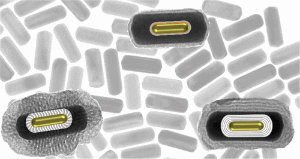our recent paper in ACS ANMGold Nanorod Coating with Silica Shells Having Controlled Thickness and Oriented Porosity: Tailoring the Shells for Biosensing

Our work on silica coating of gold nanorods is now published in ACS applied Nanomaterials
https://doi.org/10.1021/acsanm.1c02297
Abstract:
The coating of gold nanorods with a silica shell (AuNR@SiO2) is an effective way to extend their use in a wide variety of biomedical applications including biosensing, drug delivery and photothermal therapy. A silica shell offers numerous advantages as it provides more stability, frees the surface from toxic cetyltrimethylammonium bromide (CTAB), and preserves the rod shape under photothermal conditions. This shell needs to be very thin for applications such as plasmonic biosensing, while a thicker and porous shell is suited for drug encapsulation and further controlled release. We introduce herein a strategy to perform silica coating based on dissociation of tetraethylorthosilicate (TEOS) hydrolysis and condensation reactions. This dissociation is achieved by a pH modulation of the reaction medium, and, depending on selected pH conditions, AuNR@SiO2 with a thick silica shell having an organized mesoporosity aligned either parallel (AuNR@//m-SiO2) or perpendicular (AuNR@⊥m-SiO2) to the AuNR surface was generated. Moreover, when mercaptopropyltrimethoxysilane (MPTMS) was used as a surface primer prior to TEOS condensation, ultrathin and homogeneous silica shells (AuNR@t-SiO2) of controllable thickness in the range 2–6 nm were produced. While formation, at high TEOS concentration, of core-free silica nanoparticles is evidenced by TEM analysis before the purification procedure, their total elimination during the purification step was achieved by addition of a suitable amount of CTAB to ensure the colloidal stability of the core-free and core–shell nanoparticles. Complete elimination of CTAB from AuNR@SiO2 was demonstrated by XPS, Raman, and ζ-potential measurements. Finally, the efficiency of AuNR@t-SiO2 in label-free plasmonic biosensing of a model target was demonstrated and their refractive index sensitivity factor was improved by 30% compared to CTAB-capped AuNRs.
Also in the section
- Cover in ACS Sensors
- Cover Biosensors
- Article in Nanomaterials
- AuNRs
- Anis arrival
- OrNano-YouTube
- Review in Biosensors & Bioelectronics
- Webinar SCT
- Insplorion - User Meeting
- JSE 2020 - French Electron Spectroscopy Workshop
- Sunny
- Mona arrival
- CNano-SFNano Joint Congress 2019 - Dijon
- Article in ACS Applied Materials & Interfaces
- Mederic Thesis Defense
- Article in Talanta
- Article in Nanoscale Advanced
- Cover for ACS Appl. Nano Mater.
- Nice gathering
- Alexis is leaving !
- Bruno and Raphael defense
- Souhir : Invited Lecture
- Article in biosensors
- Yacine Mazouzi, price
- BioSurf 2019
- Atul Parikh
- Cover for J Phys Chem C
- Mathieu Nicolas has joined us
- Bruno & Raphael
- Insplorion
- Ceremony for Master diploma
- Lu : PhD defense
- Fadoua's arrival
- Photoniques
- Daoming arrival
- Mathieu's paper in Journal of the Optical Society of America
- Somia Tomane - Thesis Defense
- Walid's arrival
- Valentin's arrival
- David Hu - Thesis defense
- Vincent Pellas - Thesis Defense
- Paper in ACS Sensors
- Yacine Mazouzi Thesis defense
- Issue-cover selected
- Review in Antibiotics
- IEEE Sensors Council France
- IEEE Sensors
- ACS Sensors
- Sara Martinez Concheso
- PhD defense Mathieu Nicolas
- PEP21 school

